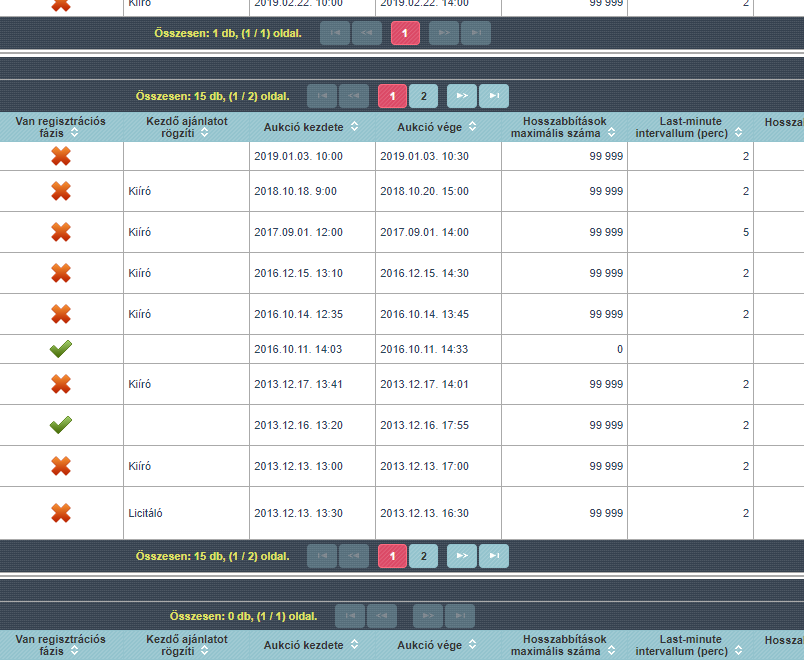The history of auctions goes back way longer than you would think. It was a popular method of selling items in ancient times already. The term itself comes from the Latin “augere” (increase).
The basic requirements for having auctions were the following: the start of coining so that bids could be compared easily, and sufficient population density so that enough prospective buyers and sellers could gather.
We learned about the earliest organised auction market from Herodotus. In Babylon, in the 5th century BCE, maidens were sold at auctions every year. Girls of marriageable age and men wishing to marry got together from several villages. The auction started with the most beautiful girl, and the man who offered the largest amount could marry her. Interestingly, the price turned negative with unattractive women: they had to offer dowry to get someone to marry them.***
One of the strangest auctions of all time was when the whole Roman Empire was put up for auction. In 193 CE, the Praetorian Guard killed emperor Pertinax, and put his head up for auction. It was announced: the person offering the most can take the throne. The highest bid, 250,000 sestertii, came from Didius Julianus. Not the best investment, though: he himself was beheaded two months later.
In Rome, assets confiscated by the state were often put up for auction. Ovid wrote that at the beginning of the common era, it became widespread that the right to collect taxes was auctioned off. It was also an effective way to sell prizes of war. Most probably it was some kind of open, ascending auction method that was used.
Auctions were used in other civilisations as well. Several sources state that from the 7th century, maintenance costs in Buddhist monasteries were partly covered by putting the belongings of deceased monks up for auction.
In the early Middle Ages, however, auctions were almost non-existent. The mobility of the population was low and there were few minted coins in circulation. In such conditions, it was practically impossible to have regular auctions. A significant part of the population was self-sustaining or lived by bartering.
In 1550, in France, art pieces and paintings were sold through auctions. The first law regulating auctions in France (1556) made auctioneering a hereditary, thus a prestigious occupation.
In Great Britain, it was the 1595 Oxford English Dictionary that first mentioned auctions. Records of regular auctions, however, only date back to the end of the 17th century. Works of art were auctioned off in coffeehouses and pubs in England at this time.
In the 18th century, the large auction houses Sotheby’s (1744) and Christie’s (1766) were established. At this time, some of the slaves in America were already sold at auctions. Tobacco, horses and land were also sold with this method. The identity of the owners was often not revealed, as putting assets up for auction was somewhat frowned upon. It was only later that auctioneers became respected members of the society.
In the United States, in the 19th century, auctioneers were already seen as people of power, people to be respected.
Auctions of certain goods like vegetables, fruit and especially fish became common in the Netherlands and in Germany at the end of the 18th century. This way fishermen could sell their catch quickly in the harbour and had more time to catch fish.
Auctions played a part in the privatisation of state-owned companies and assets in Eastern Europe and in the countries of the former Soviet Union, and in the area of transport and energy supply in the United Kingdom and in Scandinavia. In the United States, the right to use natural resources, including logging and oil exploration has traditionally been sold through auctions, and most recently, this method has been used to sell the right to use the electro-magnetic spectrum.
The sale of the rights to use the electromagnetic spectrum brought the implementation of the results of auction theory to the centre of attention. The now famous sale of the 3G mobile frequencies in England brought in astonishing amounts.
AOnline auctions opened up new possibilities, too. Before that, auctions had their geographical limits and time limits. On the Internet, a lot of sellers and buyers can come together, while transaction costs are negligible. Participants are usually required to register, and there are some regulations.
***Honestly, I’m not aware of any electronic bidding system, including ViNetBid, where bids during an auction could turn from positive to negative. If the ViNetBid system were to be used for this today, I would do the following:
1. I would ask the parents of all maidens about the maximum amount they would be willing to offer as a dowry for their daughter. The highest amount would be included in the auction notification.
2. I would hold an English auction similar to that of frequency auctions, with a cherry-picking option, and the starting price would be 0. This 0 would mean that the “buyer” would get the dowry announced if he married the ugliest maiden.
3. The price would be climbing up. For some less attractive girls, it would stop below the amount of the dowry announced. In this case, the parents of the girl would pay the difference between the amount announced and the price reached at the auction as dowry.
4. For some maidens, the price would go higher and exceed the amount announced. In such a case, the winner would have to pay the difference between the price he offered and the price announced to be able to marry the girl.
The basic requirements for having auctions were the following: the start of coining so that bids could be compared easily, and sufficient population density so that enough prospective buyers and sellers could gather.
We learned about the earliest organised auction market from Herodotus. In Babylon, in the 5th century BCE, maidens were sold at auctions every year. Girls of marriageable age and men wishing to marry got together from several villages. The auction started with the most beautiful girl, and the man who offered the largest amount could marry her. Interestingly, the price turned negative with unattractive women: they had to offer dowry to get someone to marry them.***
One of the strangest auctions of all time was when the whole Roman Empire was put up for auction. In 193 CE, the Praetorian Guard killed emperor Pertinax, and put his head up for auction. It was announced: the person offering the most can take the throne. The highest bid, 250,000 sestertii, came from Didius Julianus. Not the best investment, though: he himself was beheaded two months later.
In Rome, assets confiscated by the state were often put up for auction. Ovid wrote that at the beginning of the common era, it became widespread that the right to collect taxes was auctioned off. It was also an effective way to sell prizes of war. Most probably it was some kind of open, ascending auction method that was used.
Auctions were used in other civilisations as well. Several sources state that from the 7th century, maintenance costs in Buddhist monasteries were partly covered by putting the belongings of deceased monks up for auction.
In the early Middle Ages, however, auctions were almost non-existent. The mobility of the population was low and there were few minted coins in circulation. In such conditions, it was practically impossible to have regular auctions. A significant part of the population was self-sustaining or lived by bartering.
In 1550, in France, art pieces and paintings were sold through auctions. The first law regulating auctions in France (1556) made auctioneering a hereditary, thus a prestigious occupation.
In Great Britain, it was the 1595 Oxford English Dictionary that first mentioned auctions. Records of regular auctions, however, only date back to the end of the 17th century. Works of art were auctioned off in coffeehouses and pubs in England at this time.
In the 18th century, the large auction houses Sotheby’s (1744) and Christie’s (1766) were established. At this time, some of the slaves in America were already sold at auctions. Tobacco, horses and land were also sold with this method. The identity of the owners was often not revealed, as putting assets up for auction was somewhat frowned upon. It was only later that auctioneers became respected members of the society.
In the United States, in the 19th century, auctioneers were already seen as people of power, people to be respected.
Auctions of certain goods like vegetables, fruit and especially fish became common in the Netherlands and in Germany at the end of the 18th century. This way fishermen could sell their catch quickly in the harbour and had more time to catch fish.
Auctions played a part in the privatisation of state-owned companies and assets in Eastern Europe and in the countries of the former Soviet Union, and in the area of transport and energy supply in the United Kingdom and in Scandinavia. In the United States, the right to use natural resources, including logging and oil exploration has traditionally been sold through auctions, and most recently, this method has been used to sell the right to use the electro-magnetic spectrum.
The sale of the rights to use the electromagnetic spectrum brought the implementation of the results of auction theory to the centre of attention. The now famous sale of the 3G mobile frequencies in England brought in astonishing amounts.
AOnline auctions opened up new possibilities, too. Before that, auctions had their geographical limits and time limits. On the Internet, a lot of sellers and buyers can come together, while transaction costs are negligible. Participants are usually required to register, and there are some regulations.
***Honestly, I’m not aware of any electronic bidding system, including ViNetBid, where bids during an auction could turn from positive to negative. If the ViNetBid system were to be used for this today, I would do the following:
1. I would ask the parents of all maidens about the maximum amount they would be willing to offer as a dowry for their daughter. The highest amount would be included in the auction notification.
2. I would hold an English auction similar to that of frequency auctions, with a cherry-picking option, and the starting price would be 0. This 0 would mean that the “buyer” would get the dowry announced if he married the ugliest maiden.
3. The price would be climbing up. For some less attractive girls, it would stop below the amount of the dowry announced. In this case, the parents of the girl would pay the difference between the amount announced and the price reached at the auction as dowry.
4. For some maidens, the price would go higher and exceed the amount announced. In such a case, the winner would have to pay the difference between the price he offered and the price announced to be able to marry the girl.



